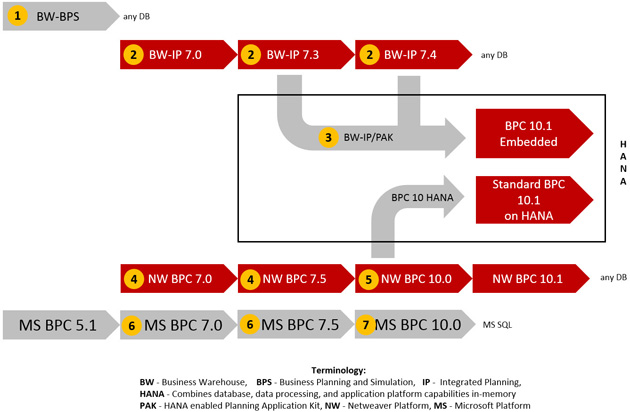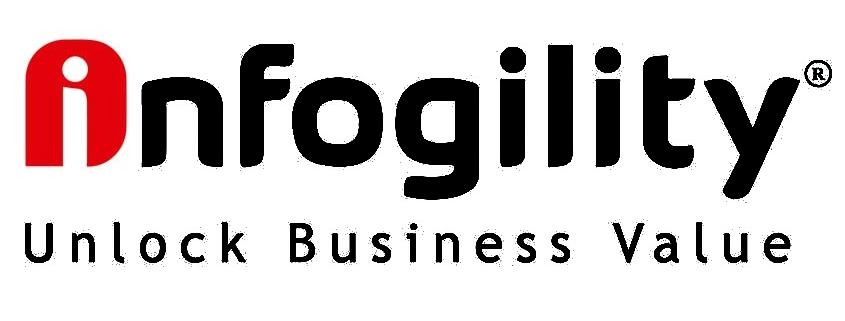SAP Business Planning – Where to go next?
 By John Louw
By John LouwPrincipal at Infogility
SAP Business Objects Planning and Consolidation (BPC) and SAP Integrated Planning (BW-IP) has come together in the latest release – SAP BPC 10.1 Embedded combines the solid back-end of BW-IP with the slick BPC Excel user experience so many of us have become accustomed to. In addition, the new web interfaces make use of HTML5, overcoming old obstacles on Mobile devices.
For organizations looking to upgrade or expand existing planning functionality, the arrival of this latest tool could be very confusing. As illustrated below, there are still numerous products out there running on different databases which could impact where you might want to go next.

Let’s explore some of the options:
1. Existing BPS Implementations
Recommendation:
- High Data Volumes or Web Client Used Extensively ->Migrate to BPC 10.1NW Embedded Model
- Low Data Volumes or Web Client not Used Extensively ->Migrate to BW-IP 7.4
Considerations:
- No standard migration tool from BPS to BPC
- Similar BW Integration and ability to use FOX formulas in BPC Embedded
- Actual conversion will involve some design and set-up of the planning objects since they are very different from BPS. Also, there will be some design and setup required to use BPC features.
- The biggest conversion item effort wise would likely be the creation of new Excel workbooks in the EPM add-in, however this could potentially be done in phases.
2. Existing BW–IP Solution Implementations
Recommendation:
- High Data Volumes or Web Client Used Extensively ->Migrate to BPC 10.1NW Embedded Model
- Low Data Volumes or Web Client not Used Extensively ->Migrate to BW-IP 7.4
Considerations:
- Since all of the BW and IP components can continue to be used in existing planning applications, a phased approach can be used when converting to 10.1 Embedded planning applications
- The biggest conversion item effort wise would likely be the creation of new Excel workbooks in the EPM add-in, however this could potentially be done in phases.
- 10.1 Embedded and BW-IP is ONLY available for Planning scenarios. Financial Consolidation could be implemented concurrently using Standard SAP BPC 10.1 leveraging the power of HANA.
3. Existing BW – IP Solution Pack (PAK) Implementations
Recommendation:
- Migrate to BPC 10.1NW Embedded Model
Considerations:
- Since all of the BW and IP components can continue to be used in exiting planning applications, a phased approach can be used when converting to Embedded planning applications
- The biggest conversion item effort wise would likely be the creation of new Excel workbooks in the EPM add-in, however this could potentially be done in phases.
- 10.1 Embedded is ONLY available for Planning scenarios. Financial Consolidation could be implemented concurrently using Standard SAP BPC 10.1 leveraging the power of HANA.
4. Existing BPC 7.X NW Implementations
Recommendation:
- High Data Volumes or Web Client Used Extensively -> Migrate to BPC 10.1NW Standard Model on HANA
- Low Data Volumes or Web Client not Used Extensively ->Migrate to BPC 10.1NW Standard Model no HANA
Considerations:
- SAP HANA is optional, but since HANA cannot be used with 7.x a big performance boost can be achieved with HANA in 10.1
- Compared to 7.x, the 10.1 Web client and EPM add-in has significantly more features and is also much easier to work with, making users more productive
- A Migration program is available
- EVDRE templates can also be migrated, however be warned that only simple EVDREs are migrated and that there are often left over areas in the workbooks that need to be cleaned up. Also, it is not true migration as the converted workbook still remain EVDRE under the skin and are not converted to true EPM Add-In reports. In most scenarios, to leverage the full functionality of the EPM Add-In these will eventually have to be entirely re-built.
- The 10.1 web client is completely new, therefore 7.x Live reports would need to be re-built.
5. Existing BPC 10.0 NW Implementations
Recommendation:
- High Data Volumes or Web Client Used Extensively ->Migrate to BPC 10.1NW Standard Model on HANA
- Low Data Volumes or Web Client not Used Extensively ->Migrate to BPC 10.1NW Standard Model no HANA
Considerations:
- Functionality is similar but the Web client is based on HTML5 vs Adobe Flex
- SAP HANA is optional
- There is a program to migrate from 10.0 to 10.1
- If data volumes are low and the web client is not used extensively then an upgrade probably does not make much sense.
6. Existing BPC 7.X MS Implementations
Recommendation:
- High Data Volumes or Web Client Used Extensively: Migrate to BPC 10.1NW Standard Model on HANA
- Low Data Volumes or Web Client not Used Extensively: Migrate to BPC 10.1NW Standard Model no HANA
Considerations:
- SAP’s strategy for future releases on Microsoft Platform is unclear
- A BW installation on release 7.3 or higher is a prerequisite
- There is no program to migrate from MS 7.X to NW 10.1
- Major platform change, including redesign and changes to the way data is extracted, transformed and loaded, e.g. SSIS packages will be replaced with BW process chains.
- EVDRE templates can also be migrated if data model is same, however be warned that only simple EVDREs can be migrated and that there are often left over areas in the workbooks that need to be cleaned up. I would expect them to be eventually entirely re-built.
- The 10.1 web client is completely new, all web based reports would need to be re-built.
7. Existing BPC 10.0 MS Implementations
Recommendation:
- High Data Volumes or Web Client Used Extensively: Migrate to BPC 10.1NW Standard Model on HANA
- Low Data Volumes or Web Client not Used Extensively: Migrate to BPC 10.1NW Standard Model no HANA
Considerations:
- SAP’s strategy for future releases on Microsoft Platform is unclear
- A BW installation on release 7.3 or higher is a prerequisite
- There is no program to migrate from MS 10.0 to NW 10.1
- Major platform change, include redesign and changes to the way data is extracted, transformed and loaded, e.g. SSIS packages will be replaced with BW process chains.
- EPM reporting Functionality is similar but the Web client is based on HTML5 vs Adobe Flex
- SAP HANA is optional
Summary
If you are already running SAP NW BPC 10, the migration to BPC 10.1 consists of simply executing a delivered migration program. If you’re already running SAP BW-IP, upgrading could also be relatively simple in that you should be able to leverage many of your existing back-end components, however new EPM reports will need to be created.
Migrating to the full blown BPC Embedded from BPC Standard is a more complicated process, however as the solutions are on the same (BW) platform, it can be done while the standard SAP BPC solution is still being productively used. Some of the major reasons for choosing this type of migration is better integration with EDW BW, Key Figure modeling capabilities, and Mobility.
For those clients not willing to invest in HANA, but require closer integration with EDW BW and the ability to leverage Key Figure modeling capabilities, there is an option to build new planning functionality utilizing BW-IP 7.4.
Whatever the decision, it is important to remember that it does not make sense to upgrade just for the sake of being on the latest version. Only consider transitioning if the additional features and functionality are required and deliver expected Return on Investment.


